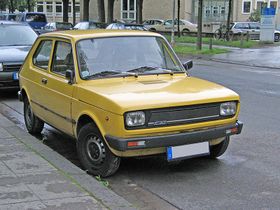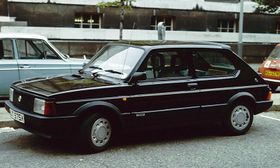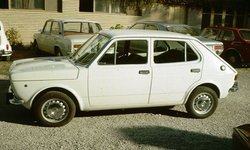Fiat 127
| Fiat 127 | |
|---|---|
| Manufacturer: | Fiat |
| Production: | 1971-1983 |
| Layout & Class: | FF supermini |
| Body Styles: | hatchback sedan |
| Predecessors: | Fiat 850 |
| Successors: | Fiat Uno |

| |
| Series I | |
| Production | 1971—1977 |

| |
| Series II | |
| Production | 1977—1981 |

| |
| Series III | |
| Production | 1982—1983 |
The Fiat 127 is a supermini produced by the Italian automaker Fiat between 1971 and 1983. It was introduced in 1971 as the replacement for the Fiat 850. Production of the 127 in Italy ended in 1983 following the introduction of its replacement, the Fiat Uno.
Overview
Initially only available as a two-door saloon, a three-door hatchback using an identical body profile was launched the following year; Fiat's first in the class. The 127 used the tried and trusted 903 cc overhead valve engine that had powered many earlier generations of Fiat cars, in conjunction with the state-of-the-art transverse engine and front wheel drive layout which had been pioneered in the Fiat 128, and also featured a unique transverse leaf spring suspension at the rear. The car was one of the first of the modern super-minis, and won praise for its utilization of space (80 percent of the floor space was available for passengers and luggage) as well as its road-holding. The 127 was an instant success, winning the European Car of the Year award in 1972, and quickly became one of the best-selling cars in Europe for several years.
The Series 2 version of the 127 debuted in 1977. It featured a restyled front and rear, a revised dashboard, larger rear glass area and a new 1049 cc engine option. This aluminum headed, overhead cam engine was unique to the 127 range. At the same time a 5-door derivative became available in certain countries. The final revision of the 127 came in 1982 with the Mark 3. Once again the front and end styling was freshened up, and a new 1301 cc engine option was introduced. The interior was redesigned and made more modern looking.
There was also a "high-cube" panel van version, known as the Fiorino which was based on the Series 2 body shell, and this remained in production until 1984, when a new Uno-based Fiorino debuted.
The Series 3 was launched in Italy in January 1982 and soon reached other European markets. It is distinguishable from the Series 2 by a more assertively plastic grill. The addition of a corresponding panel at the rear of the vehicle implied a new 'house style' inspired by the recently introduced Fiat Ritmo.
The 127 was replaced as Fiat's high volume product in this sector by the Fiat Uno in January 1983, though versions manufactured in South America continued in production till 1995: Fiat imported the South American 127 Unificata to Europe, until 1987.
Engines (from '77 on)
| Engine | Cyl. | Power | Torque |
|---|---|---|---|
| 0.9 8V | S4 | 45HP | 63Nm |
| 0.9 8V | S4 | 45HP | 64Nm |
| 1.05 8V | S4 | 50HP | 77Nm |
| 1.05 8V | S4 | 70HP | 83Nm |
| 1.3 8V | S4 | 75HP | 103Nm |
International variants
As happened with other Fiat models of that era, SEAT made a Spanish version of this car called the SEAT 127. Due to SEAT design policy, a 4-door variant of the car was produced. SEAT also produced a unique variant of the 127 OHV engine. This had 1010cc instead of 903cc and produced 50bhp.
When their license from Fiat expired, SEAT redesigned some parts of the car and created the SEAT Fura Dos. Some design parts of this model were also used in the Ibiza mark 1. SEAT produced 1.238.166 units of the 127 between 1972 and 1984.
In Brazil a 3-door wagon version was produced, called Fiat 147, one version actually utilizing a 1.3L Diesel engine. From 1981 this variant was actually exported to Europe, to be sold alongside the 127 sedans and hatchbacks. A total of 1.169.312 units were built from 09/07/1976 to the end of 1985 in Brazil and 232.807 units were also built in Argentina between 31/03/1986 and 1996, also called 147 Spazio.
The 127's underpinnings were also used in certain Fiat-sponsored products such as the Yugo 45 (Zastava Koral) from Yugoslavian Zastava company and the Fiat 147 of Brazil.
Movie Roles
In the 1986 film Gung Ho, centered on a (fictional) Japanese auto manufacturer reopening a shutdown automobile factory in a fictional western Pennsylvania town, some of the movie's "Assan Motors" cars were in various stages of completion.
External links
- FIAT Motor Club (GB)
- FIAT Encyclopedia

- Bruce's Parts Bin - Fiat Parts
- Mirafiori.com
- Dino Enterprises - New Zealand
- Fiat 147 history in Portuguese

- Fiat 127 Club Nederland

- fiat-racing.dk - A Fiat 127 racing team

| <- Previous Fiat car timeline, European market, 1960s-1980s Next -> | ||||||||||||||||||||||||||||||||||||||||||||||||||
|---|---|---|---|---|---|---|---|---|---|---|---|---|---|---|---|---|---|---|---|---|---|---|---|---|---|---|---|---|---|---|---|---|---|---|---|---|---|---|---|---|---|---|---|---|---|---|---|---|---|---|
| Type | 1960s | 1970s | 1980s | |||||||||||||||||||||||||||||||||||||||||||||||
| 0 | 1 | 2 | 3 | 4 | 5 | 6 | 7 | 8 | 9 | 0 | 1 | 2 | 3 | 4 | 5 | 6 | 7 | 8 | 9 | 0 | 1 | 2 | 3 | 4 | 5 | 6 | 7 | 8 | 9 | |||||||||||||||||||||
| City car | 500 | 126 | ||||||||||||||||||||||||||||||||||||||||||||||||
| 600 | 133 | Panda | ||||||||||||||||||||||||||||||||||||||||||||||||
| Supermini | 850 | 127 | Uno | |||||||||||||||||||||||||||||||||||||||||||||||
| Small family car | 1100 | 128 | Ritmo | Tipo | ||||||||||||||||||||||||||||||||||||||||||||||
| 1300 | 124 | 131 | Regata | |||||||||||||||||||||||||||||||||||||||||||||||
| Large family car | 1500 | 125 | 132 | Argenta | Croma I | |||||||||||||||||||||||||||||||||||||||||||||
| Executive car | 2300 | 130 | ||||||||||||||||||||||||||||||||||||||||||||||||
| Coupé / Roadster | Dino / 124 Sport Spider | 124 Sport Spider | ||||||||||||||||||||||||||||||||||||||||||||||||
| 124 Coupé | ||||||||||||||||||||||||||||||||||||||||||||||||||
| Sports car | 850 Spider | X1/9 | ||||||||||||||||||||||||||||||||||||||||||||||||
| Panel van | Fiorino I | Fiorino II | ||||||||||||||||||||||||||||||||||||||||||||||||
| Compact MPV | 600 Multipla | |||||||||||||||||||||||||||||||||||||||||||||||||
| Van | 600 T | 850 T | 900 T | |||||||||||||||||||||||||||||||||||||||||||||||
| 1100 BLR / ELR / I / T | 238 | |||||||||||||||||||||||||||||||||||||||||||||||||
| 241 | 242 | |||||||||||||||||||||||||||||||||||||||||||||||||
| Daily* | ||||||||||||||||||||||||||||||||||||||||||||||||||
| Ducato I | ||||||||||||||||||||||||||||||||||||||||||||||||||
| Off-road | Campagnola (1101) | Campagnola (1107) | ||||||||||||||||||||||||||||||||||||||||||||||||
| *Rebadged Iveco model | ||||||||||||||||||||||||||||||||||||||||||||||||||



